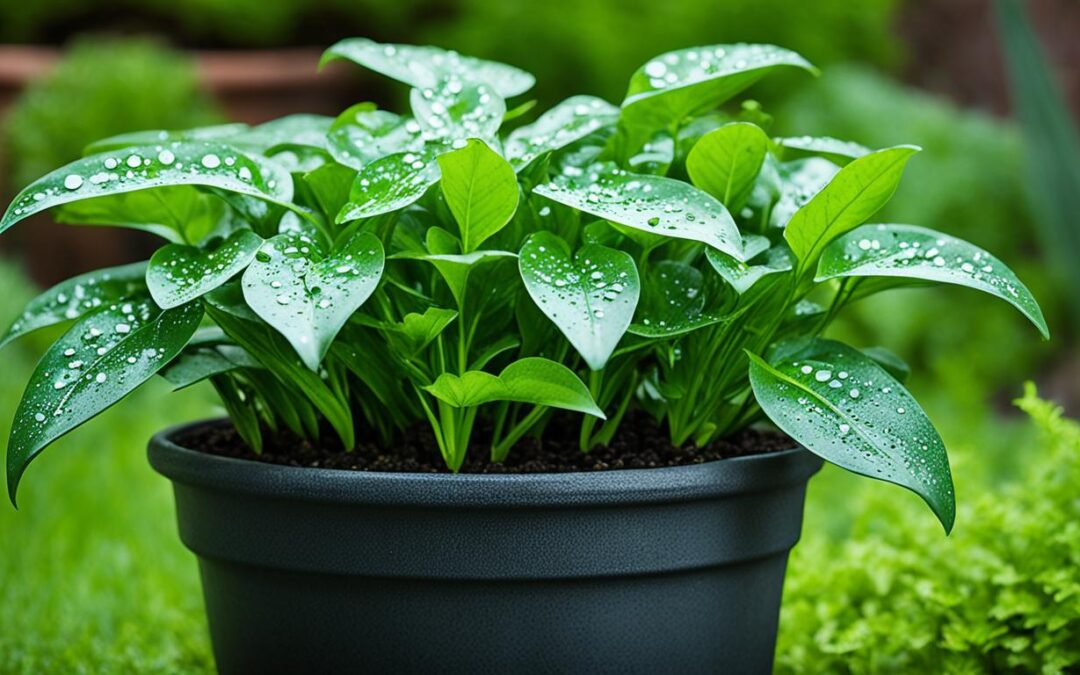Welcome to our guide on caring for cast iron plants. Are you looking for a plant that’s easy to care for and loves low light? The cast iron plant fits the bill perfectly. It has dark green leaves and is very strong.
This plant can handle not being watered regularly. It’s also happy in the shade outside. Its leaves are long and look very nice. Cast iron plants come from Japan and China. They like soil that drains well. The soil can be a little sour or neutral.
We’re here to help you get the most out of your cast iron plant. We will talk about the best light and water for it. And what temperature and humidity it likes. By following our advice, your plant will grow big and beautiful.
Key Takeaways:
- Cast iron plants are low-maintenance houseplants that thrive in low light conditions.
- They can be grown indoors or outdoors in containers and shade gardens.
- Cast iron plants prefer well-draining soil and a slightly acidic to neutral pH.
- Watering should be done when the top inch or two of soil is dry to prevent overwatering.
- They can tolerate a temperature range of 60-75 degrees Fahrenheit and standard household humidity levels.
Light Requirements for Cast Iron Plants
Cast iron plants, or Aspidistra elatior, thrive in low-light places, perfect for indoors. They grow best with medium to bright indirect light.
Avoid direct sunlight on cast iron plants. It can harm their dark green leaves by causing them to bleach or burn. Instead, choose a spot with medium to bright light but away from direct sun.
For those growing these plants outside, pick a shady area with indirect light. Cast iron plants can prosper in low-light without the need for direct sunshine.
It’s essential to find the right balance of light. Even though they can live in the dim, some brightness is needed for healthy growth.
| Light Conditions | Suitability for Cast Iron Plants |
|---|---|
| Low-light conditions | Thrives and grows well |
| Medium to bright indirect light | Optimal growth and lush foliage |
| Direct sunlight | Avoid to prevent leaf damage |
| Shady areas with indirect sunlight | Well-suited for outdoor growth |
In conclusion, right lighting is crucial for cast iron plants to keep them healthy and green. Indoors or outdoors, stick to medium to bright indirect light, and keep them away from direct sun. This way, these tough plants will do well even in the shade.
Watering and Soil Requirements for Cast Iron Plants
Proper watering and soil are key for cast iron plants to grow well. They need the right care for their beauty and life to last.
Soil Requirements: Cast iron plants do best in soil that drains well. A mix of peat moss, perlite, and potting soil is great for their roots. This kind of soil stops too much water, which can harm the roots. It helps avoid overwatering and root rot.
Watering: Let the soil dry up a bit between waterings to keep them healthy. These plants like their soil on the dry side before more water. Use your finger to check the soil’s moisture. If it’s dry a couple of inches down, time to water. Make sure the water drains out of the pot well when you water.
Remember: The key is to find a balance. Avoiding overwatering will prevent root rot, while allowing the soil to dry out completely may lead to underwatering, causing stress to the plant.
Cast iron plants are so strong they do okay even if they’re not watered perfectly. It’s safer to water them a bit less than too much. They’re used to not getting a lot of water. It’s easier to help them if they’ve dried out than if they get too much water.
These plants do better if you don’t water them too often. Remember, less water is usually better than too much for them.
| Watering Tips | Soil |
|---|---|
| Water thoroughly but infrequently. | Use well-draining soil that allows the excess water to drain away. |
| Avoid standing water or waterlogged soil. | Mix peat moss, perlite, and potting soil for an ideal soil mixture. |
| Allow the top inch or two of soil to dry out before watering. | Ensure the pot has drainage holes to prevent water accumulation. |
Follow these watering and soil tips to keep your cast iron plants looking great. Good care for the roots means pretty, healthy leaves.
Temperature and Humidity Requirements for Cast Iron Plants
Optimal Temperature Range
Cast iron plants like it between 60 and 75 degrees Fahrenheit. They can grow in or outside in this temperature. But, they don’t like it cold and might die below 50 degrees. For plants in outdoor pots, bring them in before frost comes.
Humidity Considerations
Cast iron plants are okay with the usual humidity in homes. But, if your place is very dry, they might need more moisture. You can add humidity by using a water tray or a humidifier. The right humidity levels help your plant grow well.
Expert Insight
“Cast iron plants do well in regular home temperatures and humidity. Just keep them from getting too cold and they’ll grow beautifully green for you.”
To make your cast iron plants happy, watch the temperature and humidity. The right care lets you enjoy their green leaves in your house or garden.
Fertilizing and Propagating Cast Iron Plants
It’s very important to know the right way to feed and make more cast iron plants. Doing this, you help your plants grow strong and look great. Now, let’s check out how to feed and spread these plants.
Fertilizing Cast Iron Plants
Cast iron plants should get fertilizer once a month in spring and summer. You can use either all-purpose liquid fertilizer or slow-release fertilizer. Each type has its benefits for your plant.
An all-purpose liquid fertilizer is easy to use. Just mix it with water as the label says. Then, pour it on your plant after watering. This way, your plant gets food evenly without harming the roots.
Or, try a slow-release fertilizer for houseplants. Use it in spring, following the label for how much to use. With this type, the plant gets food slowly over time, keeping it healthy.
Remember not to feed your plant in fall and winter. It doesn’t grow much then. Too much food can hurt its roots or build up in the soil.
Propagating Cast Iron Plants
It’s easy to make more cast iron plants by dividing them. This mean taking parts of a big plant to grow new ones.
Do this in spring or early summer. The plant is growing fast then. Here’s how to do it:
- Take the plant out of its pot carefully, so you don’t hurt the root.
- Look for parts where you can separate the plant into pieces.
- Use a clean knife or shears to cut the plant into sections. Each part should have a few leaves.
- Get some pots ready with soil.
- Put the plant sections in their pots, making sure each one is covered with soil.
- Water them a little, making sure the soil is damp, not wet.
- After they’ve grown some more, water them like you usually do.
You can only divide plants that are already big and healthy. Following these steps, you can grow more cast iron plants. This way, you can enjoy more of these strong houseplants.
Summary
Feeding and spreading cast iron plants the right way is crucial. Using the right fertilizer in spring and summer helps your plants grow well. Dividing them lets you have more beautiful plants. With some care, your cast iron plants will flourish, adding beauty indoors and out.
Conclusion
Take care of a cast iron plant is easy. It’s a top pick for new or experienced plant lovers. It loves low light and doesn’t mind if you forget to water it sometimes. This makes it an excellent choice for those who are busy or have tricky spaces to grow plants.
To keep your cast iron plant happy indoors or out, make sure it gets the right amount of light, water, soil, and the correct temperature. This plant prefers low-light areas. Stay away from putting it under direct sunlight; it can burn the leaves. Use soil that drains well. Let the soil dry before watering again. It likes room temperatures between 60 and 75 degrees Fahrenheit. Watch out for any signs it’s too hot or cold. Moreover, the air should have enough moisture. Add more water to the air if it gets too dry.
Don’t forget to feed your cast iron plant. Do this every month in spring and summer. You can use a special plant food that’s mixed with water or one that releases slowly. If you want to make more plants, split it when it’s growing well. Then, put the separated parts in their pots with holes at the bottom.
If you follow these steps, your cast iron plant will grow strong and lovely. It will make your home or garden more beautiful. Enjoy taking care of it!

